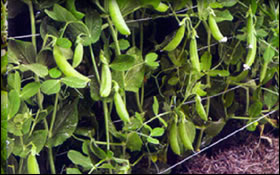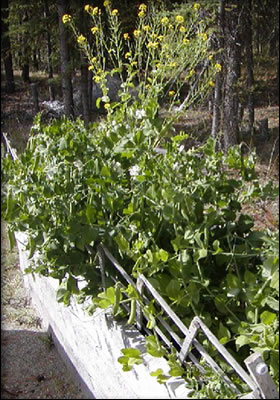 The Scientist: The Scientist:
Corinne Jager BSc(Hons)
School of Plant Science, University of Tasmania
Corinne grew up in Dover - a small country town one hour south of Hobart. She went to the local district school until grade ten and then moved to Hobart for college and university.
When Corinne began her degree she was originally interested in how the human body worked so she took human biology subjects. At the same time she enrolled in plant science, which eventually became her major, followed by honours in genetics.
“I became interested in research when I took the plant science research project as a third year course and enjoyed the hands on aspect and the freedom of organising my own work,” Corinne says.
Corinne is currently in her last year of her PhD in plant science. The focus of her work is the interaction between the ‘classical’ plant hormones and the steroid hormones (brassinosteroids) in relation to plant growth and development.
This involves research in the lab and glasshouse and producing papers for publication in scientific journals.
“The majority of my work is analysing endogenous levels of plant hormones in normal plants and then comparing them to levels in brassinosteroid mutants (the mutant plant doesn’t have any brassinosteroids). This enables me to determine what plant processes brassinosteroids are involved in,” Corinne says.
To analyse the hormone levels, Corinne extracts them from the plant by grinding and filtering the plant tissue, and then analyses the samples using HPLC (high performance liquid chromotography) and GC-MS (gas chromatography - mass spectrometry). She also uses radiolabelled plant hormones to determine how and where the hormones are moved and metabolised throughout the plant.

Garden pea field experiments
Corinne’s work has found that plants lacking these brassinosteroid hormones also have altered levels of other growth hormones, such as auxin and gibberellins, showing that brassinosteroids are important for maintaining normal plant growth and development.
“One of the great things about science is that there are so many areas that you can work in, many of which you are unaware of during school. I love that I am studying something as basic as plant growth yet so much is still unknown, so all my findings are new and exciting,” Corinne says.
The only other similar research to Corinne’s is carried out overseas, so there are great opportunities for her in networking and travel. Corinne believes that scientists are very important people because they are behind the majority of breakthroughs in our society.
More About the Work:
Key words: Plant growth, Hormones, Brassinosteroids
Hormones are important in regulating all aspects of our body, from our energy levels to deciding when we mature from girls and boys into women and men. Just like animals, plants use hormones for normal healthy growth.

Garden pea field experiments
Brassinosteroids (BRs) are a relatively new group of plant hormones that are involved in diverse processes including cell growth, stem elongation, vascular tissue development, and regulation of gene expression. This project is characterizing several new brassinosteroid-related mutants of pea, and examining the interaction of BRs with other plant hormones, including gibberellins and auxin.
Brassinosteroids, are one of six types of plant hormones and are considered to be very important for promoting plant growth - at every stage, from germinating, growing branches, flowering, dying back to regenerating. In addition, they are involved such diverse processes as stem elongation, vascular tissue development, and regulation of gene expression.
The study of these hormones is very important because if we understand how plants regulate their growth we can create plants that have superior growing abilities and for example, are resistant to certain problems like drought. By comparing the growth of plants with and without specific brassinosteroids and observing at what stage the plant has growing difficulties, scientists can learn the purpose of that particular brassinosteroid.
Most of these studies are conducted on peas because peas have been used in plant science for many years and plant scientists have a great deal of knowledge about their genes.
Corinne’s project involves characterizing several new brassinosteroid-related mutants of pea, and examining the interaction of brassinosteroids with other plant hormones, including gibberellins and auxin.
Websites:
Brassinosteroids, a new class of phytohormones
https://www.ias.ac.in/currsci/may252002/1239.pdf
School of Plant Science, University of Tasmania
https://www.utas.edu.au/plantsci
|
